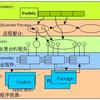The decoding of brain signals recorded via, e.g., an electroencephalogram, using machine learning is key to brain-computer interfaces (BCIs). Stimulation parameters or other experimental settings of the BCI protocol typically are chosen according to the literature. The decoding performance directly depends on the choice of parameters, as they influence the elicited brain signals and optimal parameters are subject-dependent. Thus a fast and automated selection procedure for experimental parameters could greatly improve the usability of BCIs. We evaluate a standalone random search and a combined Bayesian optimization with random search in a closed-loop auditory event-related potential protocol. We aimed at finding the individually best stimulation speed -- also known as stimulus onset asynchrony (SOA) -- that maximizes the classification performance of a regularized linear discriminant analysis. To make the Bayesian optimization feasible under noise and the time pressure posed by an online BCI experiment, we first used offline simulations to initialize and constrain the internal optimization model. Then we evaluated our approach online with 13 healthy subjects. We could show that for 8 out of 13 subjects, the proposed approach using Bayesian optimization succeeded to select the individually optimal SOA out of multiple evaluated SOA values. Our data suggests, however, that subjects were influenced to very different degrees by the SOA parameter. This makes the automatic parameter selection infeasible for subjects where the influence is limited. Our work proposes an approach to exploit the benefits of individualized experimental protocols and evaluated it in an auditory BCI. When applied to other experimental parameters our approach could enhance the usability of BCI for different target groups -- specifically if an individual disease progress may prevent the use of standard parameters.
翻译:通过电子脑图等手段记录的大脑信号解码过程,使用机器学习是大脑-计算机界面(BCI)的关键。根据文献,通常选择BCI协议的激励参数或其他实验设置。解码性性能直接取决于参数的选择,因为这些参数对所获取的大脑信号和最佳参数有影响,取决于主题。因此,实验参数的快速和自动选择程序可以大大提高BCI的可用性。我们评估了独立随机搜索和混合贝叶西亚优化方法,在闭路镜事件相关的潜在协议中随机搜索。我们的目标是寻找个人最佳刺激速度 -- -- 也称为“刺激性启动”协议(SOA) -- -- 以个人最佳刺激速度 -- 也称为“刺激性启动”协议。解码性表现直接取决于参数的选择,因为这些参数影响到了正常的大脑信号信号信号和最佳参数。为了让Beesian优化在网上BCI实验所带来的时间压力下可行,我们首先使用离线模拟方法来初始化和限制内部优化模型。然后我们用13个健康主题对我们的在线方法进行了评估。我们可以显示,在13个主题中选择了8项中的个体最佳刺激性目标值,而实验性选择了一种实验性实验性实验性选择了一种SOA的实验性模型,但B的实验性方法则能够使SOA的实验性评估了一种最佳的实验性实验性评估了SOA 。



